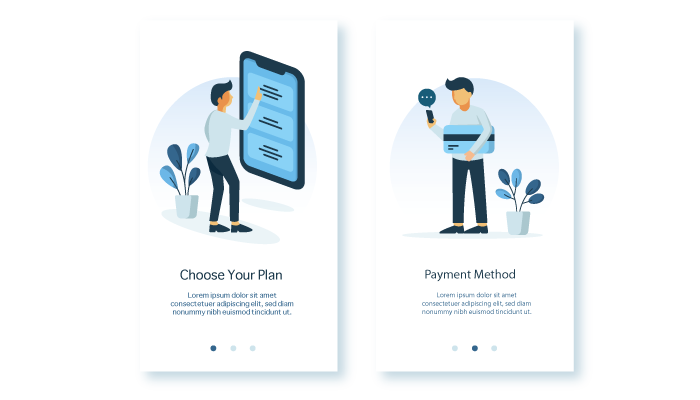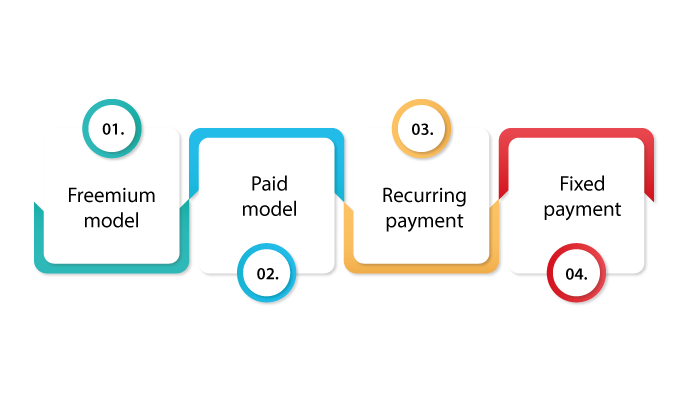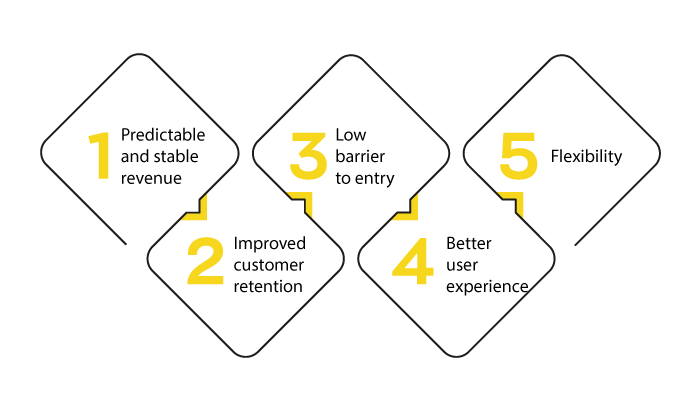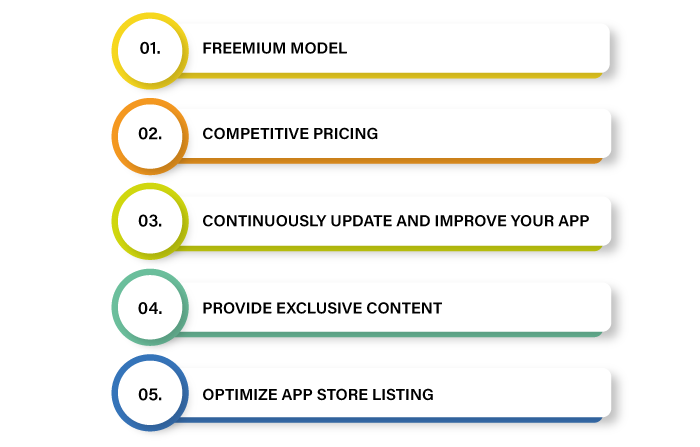You have made Subscription-based apps. You have won one battle. Yes, developing an app is not an easy feat; it takes a lot of dedication and hard work. Mobile app development is not the last stage but regular update and monetization is what you need to be successful in this niche.
When it comes to subscription-based apps, the saying “You get what you pay for” rings true. With free apps may seem appealing they often come with limited features and access to content.
If you have ever found yourself scrolling through the app store, wondering whether you should pay for that premium version of your favorite app? You are not alone.
The subscription model is all about building long-term relationships with customers by providing consistent value and service.” – Tien Tzuo
Subscription-based apps have taken the world by storm, offering users access to a range of premium content and features for a recurring fee.
Some of the most popular subscription-based apps include streaming services like Netflix, and Hulu as well as fitness apps like Peloton and Fitbit.
But what exactly are subscription-based apps and how do they work?
Statistics of Subscription-based Apps

In the race for the subscription-based app, the top-grossing apps on the App Store are TikTok, Tinder, YouTube, Disner+, and Pandora.
Let’s look at the latest statistics on Subscription-based apps:
- Subscription revenues of media and digital content are expected to grow by over 13.5%
- It is expected to grow by over 13.5% with consumers generating 1.26 trillion USdollars on services with recurring billings by the end of 2025.
- Annual spending in top subscription apps worldwide on the play store is $4.8 Bn
- On the app store US user spending on subscription-based apps is over $6 BN
What are subscription-based apps?

When it comes to the best subscription based apps, Netflix, Spotify comes to mind. These apps are mobile applications that offer access to premium features and content for a recurring fee.
Instead of charging a one-time fee for access to the app, subscription based apps require users to pay a regular fee. So that they continue to use the app and its features.
Moreover, these apps are popular in a range of industries, including media, entertainment, education, and fitness. Some popular subscription based apps examples include Netflix, Headspace, Microsoft 365, and many more.
For developing popular apps like Netflix and Spotify, it took a huge amount of
Subscription-based apps are free to download on the app stores. Most businesses prefer this mobile app monetization strategy. Let’s discuss it deeply in the next section.
Why apps are subscription-based?

Most of the companies choose an app subscription based business model as they don’t break the flow of revenue.
With a subscription based model, app developers allow them to continue improving and updating the app over time. Plus, this type of model helps them to execute long-term strategies.
Another advantage of a subscription based app is that it fosters a long-term relationship between the developer and user. This can lead to greater loyalty and retention.
It is recommended to start mvp app development before investing in the subscription based model.
By continually providing value to the user through new features and content, subscription-based apps can create a loyal customer base that is more likely to continue using the app over time.
However, the subscription-based model offers benefits to both developers and users making it a popular choice for many mobile applications.
Types of models used in subscription-based apps
Freemium model
Downloading of apps is free. The free version includes limited features. This is the best way to monetize the app. As for accessing more features, users have to buy the premium pack.
Moreover, freemium offers a way to test the app free to developers. If he is enough confidence to give his app for free. This means he can be in demand for paid features.
Paid model
When it comes to a premium model, it is the one Apple used for the app store. With this idea, you have to pay a sum of money like $30 or $40. And now you can install a whole bunch of apps.
Recurring payment
With these features, it involves paying a monthly or yearly fee for using premium features. For example –Netflix, LinkedIn, Spotify, etc.
Fixed payment
For accessing complete content regularly fixed payments are subscriptions that require a flat fee. Once you have bought an app, it’s free to use forever.
With this, you don’t have to worry about the subscription running out or losing access to the app.
Overall, if you want your subscription based app model to be successful, just hire mobile app developers with experience in developing subscription based apps.
Benefits of subscription-based app models

There are several benefits of subscription based business model, it provides flexibility, Lower barrier to entry, improved customer experience, and many more.
Predictable and stable revenue
Subscription-based apps offer a reliable revenue stream for developers. This allows them to plan and execute long-term strategies for app development & improvement.
Improved customer retention
Whether it’s subscription-based food delivery app or any app by providing regular updates and new features it can foster long-term relationships with its users. This can lead to greater loyalty and retention at the same time.
Low barrier to entry
Subscription-based offer a lower cost of entry for users, which can make the app more accessible to a wider range of users.
Better user experience
When it comes to the subscription manager app it often provides a more engaging & personalized for users. As the app is tailored to their needs and preferences.o
Flexibility
It often offers users the flexibility to cancel or modify their subscription at any time, giving them more control over their experience with the app.
Let’s look at some additional benefits of subscription-based apps:
| Apple incentive
| Developers who make over $1m annually get 70% of revenue, increased to 8% for renewals after the first year. |
| Reliable higher revenue
| Subscriptions offer higher and more predictable revenue, improving cash flow. |
| Ad free experience
| Users enjoy uninterrupted journeys without in-app ads |
| Higher engagement
| Subscribers value their money and stay engaged with the app more regularly. |
| Automatic renewals
| Subscriptions automatically renew, improving the app’s retention rate. |
How Does Subscription-Based App Work?
If you have subscription based app ideas, the first thing that comes to your mind is how they work.
These apps work by offering users access to premium features or content for a recurring fee. Users can subscribe to the app’s services on a monthly or yearly basis.
Moreover, the app’s services are on a monthly or yearly basis, and the app typically offers different subscription tiers with varying levels of access.
When a user subscribes, they provide payment information that is securely stored by the app store. So once the user subscribed to subscription-based social media apps the app store handles the billing & payment processing. Plus, they split between the app developer and the app store.
Once a user is subscribed, they can access the premium features or content for as long as their subscription is active. Many subscriptions based dating apps offer automatic renewals or allow users to renew their subscriptions.
With this let’s look at some types of apps with subscription-based models.
Types of apps succeed at the subscription-based model

Whether it’s the OTT platform or any other app that finds subscriptions all generate a good amount of revenue. Also, you can make an app like doordash , it is a best example of subscription based model.
Without further ado, let’s look at successful subscription-based models such as:
Streaming Media & entertainment apps
NETFLIX, Amazon Prime, and Spotify offer access to exclusive content & ad-free listening making them popular choices for subscription based models.
If you are planning to create your own ott platform, it is recommended to hire a genuine app developer and generate revenue by making it subscription based.
Productivity apps
Apps like Headway helps users to improve their productivity, such as task management or note-taking apps. It can also benefit from a subscription-based model by offering advanced features or integrations.
Health & wellness apps
Some of the best Fitness Apps that provide personalized fitness plans, meditation sessions, or nutrition advice have become increasingly popular among health-conscious consumers.
Gaming apps
Many mobile games have successfully implemented these models by offering in-game rewards or exclusive content for subscribers.
Educational apps
Learning apps, online courses, and other educational apps thrive with subscription models. They provide users with access to premium content or personalized learning experiences.
Tips to ensure the success of your app subscription model

With these tips, your app will stand out and provide a unique value proposition for subscribers. Plus, listen to the feedback and use it to make improvements to the app and the subscription model.
Freemium model
Provide a free trial period to allow users to try your app before purchasing a subscription. With this, it will create trust among users and increase the client retention rate.
Competitive Pricing
Researching the pricing of similar apps in your market will increase your chances of success. Plus, offer a pricing model that is competitive and reasonable.
Offer personalized experiences
Personalizing the user experience can help build a loyal subscriber base. Consider offering personalized recommendations or customizing app features to user preferences.
Continuously update and improve your app
Regularly updating and improving your app can help keep users engaged and demonstrate your commitment to providing them with value for their subscriptions.
Provide exclusive content
Providing exclusive content, features, or benefits to subscribers can make your app more valuable to users. This will make them pay for a subscription.
Optimize app store listing
Another way to succeed in your app subscription model is to make sure your app’s description, keywords, and visuals are clearly communicated.
Use data to make informed decisions
Regularly review and analyse data related to user engagement, subscription churn, and revenue to make informed decisions about pricing, features, and marketing efforts.
Conclusion
Streaming apps, fitness apps, and many other subscription-based models can be seen as very successful and generate huge amounts of revenue. This is why, now is the right time to invest in subscription based mobile app development.
Not only they are reliable for revenue stream but also provide user higher engagement and ad-free experiences for users.
However, it is important to keep in mind that the potential drawbacks such as regular updates are necessary for the app’s success. If you have a well-executed subscription based app can provide you with a win situation for both developers and users. By providing a valuable service while generating a reliable source of revenue.
If you have more queries regarding the subscription-based model feel free to contact us.
FAQ
Subscription-based apps are mobile applications that require users to pay a regular fee (usually monthly or annually) to access premium features and content.
Users typically download the app for free and can use some basic features or content without a subscription. However, to access premium features and content, they need to subscribe to the app by paying a regular fee.
Some popular subscription-based apps include Netflix, Spotify, Headspace, and Microsoft 365.

Udai Singh is a senior content writer with over 6 years of experience in creating content for FinTech, eWallet, EdTech, and App Development. He is an expert in simplifying complex concepts and creating engaging content that resonates with the audience.
Table of Contents












No Comments
Comments are closed.